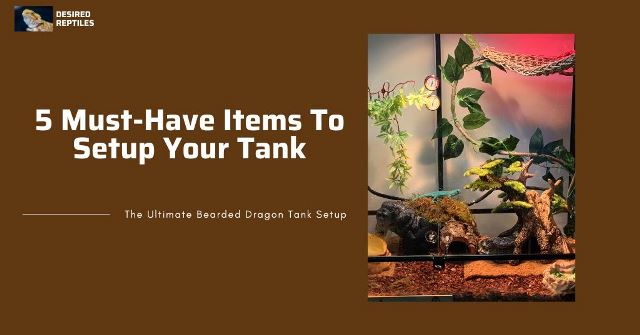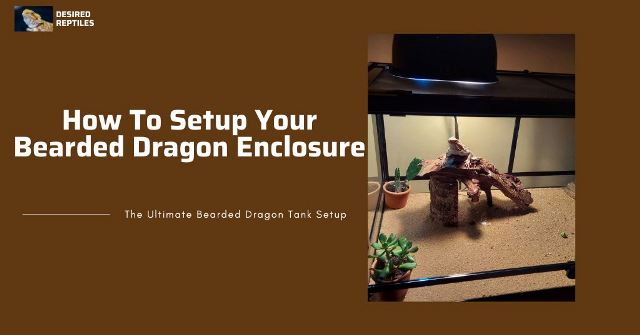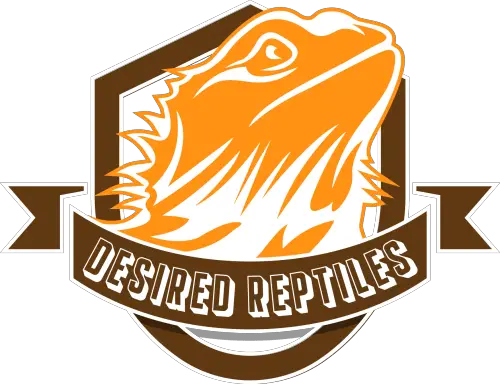Beardies are naturally inhabitants of the Australian deserts where several factors are ideal for their survival. They are not wired to live in humid environments and this is the problem. You have to create a replica of the natural bearded dragon habitat for them to coexist with you in your environment.
As a beginner, this may seem difficult; there are a gazillion guides that swear they’re the best methods for setting up a bearded dragon tank. Today, the argument on whether sand is a good substrate or not still stands, along with other conflicting ideas like placing a water bowl in the enclosure. So, how do you set up the best home for your bearded dragon on a budget?
In this article, I’ll take you through the easiest process of setting up a beardie tank, reviewing what you need to create a safe setting for your bearded dragon to thrive. Let’s get right into it!

The 5 Major Items You Need To Set Up a Bearded Dragon Tank
There are staple items needed to set up a bearded dragon tank. Think of this section as your comprehensive checklist that will guide you to what you need for the enclosure.
Quick list of the stuff you need:
- The Tank
- Lighting
- Substrate
- Monitoring devices
- Tank accessories
1. The Tank (Terrarium)
Bearded dragon enclosures come in different sizes and of various materials, all with their pros and cons. The customizations of the enclosure and the reason you want to keep a beardie (for breeding purposes or just as a pet) determine the type of tank you need.
How big of a tank does a bearded dragon need?
When choosing a bearded dragon terrarium, the best thing to do is to start with a large enclosure – a 100-gallon to 300-gallon tank – (view on Amazon) so that when your beardie reaches adulthood, you don’t spend more money changing or upgrading. The textbook ‘expert-recommended’ beginner tank size is 25 to 50 gallons but if you get these, you’d only get 3 to 5 months of use before your beardie outgrows them.
There are 3 major tank types to choose from, and I have highlighted their strengths and weaknesses to help you decide what you need.
Glass Tank
Glass enclosures are the most popular type of terrarium for bearded dragons. They are easy to clean, reflect light properly, hold zero room for bacteria to thrive, and last long with good use making them efficient. However, they also break easily, are heavy, and are ridiculously expensive to purchase. If you overlook these cons, they are the best option you can get.
Expense-Cutting Tip:
Consult with professional breeders on where to get hand-me-down terrariums. They may have one or two lying around their store that could be sold to you if you’re on their good side.
Another good tip is to purchase aquariums from aquarists. Since aquariums are made to hold water, they would be much more durable and suitable for your bearded dragon. The aquariums may have a few cracks that you can purchase for a lower price and patch up later. Just be careful not to choose an overly damaged tank because you’d be at a loss with the cost of repairs.
Wooden Tank
Wooden tanks are also pretty common choices to house bearded dragons, and they are cheaper than glass and plastic enclosures (view on Amazon). They typically have three sides made out of wood with one side (viewing side) made of glass where you can see your beardie through. However, they’re prone to molding and housing bacteria, which is dangerous for your beardie’s health and requires more effort to maintain. Ultimately, the regular maintenance results in them not lasting as long as glass terrariums.
Plastic Tank
Plastic or acrylic terrariums can be either very simple and affordable (view on Amazon) or high-grade durable and expensive. The expensive ABS plastic tanks cost an arm and leg to purchase, but they are sturdy for housing bearded dragons and are easy to clean and maintain.
The cheaper plastic terrariums are made of regular plastic which is prone to damage and highly reactive to heat. The last thing you want is for your bearded dragon to inhale hazardous fumes when the temperature gets high in the tank. Therefore, I do not recommend regular plastics.
2. Lighting and Basking Fixtures
Beginners are usually instructed to “just start somewhere”, but I can confirm that it is one of the worst pieces of advice you can take as the lighting is highly crucial to your pet’s health. Basking bulbs don’t beep alarms to indicate when they cease to produce UVB rays – the energy source for beardies – which is why you must use durable ones to prevent your pet from falling ill.
UVB lamps provide the Vitamin D necessary for growing strong bones, while basking lamps provide heat that helps activate metabolism during digestion. One of the major effects of poor UVB exposure in bearded dragons is metabolic bone diseases, which usually start at the early stages of their development and then affect them as they age.
Do not rely on one lamp alone to deliver both heat and UVB rays or else your bearded dragon will have to choose between basking under heat to receive the required UVB rays or relaxing in the shade and receiving none.
The UVB lamp must cover the majority of the terrarium so that your pet can receive it even when not basking. To complement this, the basking lamp must be on a fixed spot to preserve the temperature gradient in the tank; this allows your pet to move away from the heat and cool off after basking.
What you need to ideally light up your bearded dragon enclosure is a 2-in-1 heating and UVB lamp (view on Amazon) that emits both heat and UVB rays paired with a fluorescent UVB ray lamp (view on Amazon) so that your beardie can get some active vitamin D beams while it cools off after basking.
Avoid the starter pack coil UVB heat bulbs that pet stores try to sell you! They die out quickly exposing your pet to further illnesses or complications.
“Should I get a night (tinted) lamp for my bearded dragon tank?”
It is dangerous to keep your beardie in tinted light all through the night no matter how promising the light bulbs are as it could ruin its sleep routine and weaken its immune system. Imagine you had to sleep with red light beating on your eyelids – it would be horrible! I do not recommend this idea.
3. Substrate and Flooring
The substrate is one of the most controversial topics in setting up a beardie enclosure, often leaving you to rely on “practice and fail” methods. The truth is that there will always be pros and cons to every flooring type.
The best type of flooring for baby bearded dragons is simple paper. You can maintain this method until they are at least 7 months old to give them a better chance of building their immunity. This is also because hatchlings make a lot of mess; you’d appreciate the easy maintenance that comes with paper if you’re a beginner.
After the bearded dragon has exceeded 7 months and grown into an adult, consider moving it to a more natural flooring type such as a mix of sand, topsoil, and clay that replicates its natural environment.
The substrate should be slightly compacted so that your pet can walk on it without its little legs sinking in and still be able to dig around. To get this result, use a blend of 60% topsoil, 30% sand, and 10% clay. I find the usual 50% sand, 30% soil, and 20% clay blend too loose for thorough cleaning; poop and other waste filters through easily, compromising the hygiene of the tank, and encouraging bacteria to grow.
The table below provides a quick overview of various types of flooring, including their pros and cons.
| Flooring Type | Pros | Cons |
|---|---|---|
| Sand + Soil + Clay mix | Great for adult beardies Allows for natural beardie behavior like digging Improves overall experience | Can be a bit pricey to get good options Can be harmful to baby beardies |
| Paper | Great for baby beardies Easy to maintain Affordable | Not ideal for adult beardies Unnatural; can lead to stress |
| Wood | Affordable Easy to clean | Unnatural Can encourage the growth of bacteria Wears easily due to cleaning |
| Wood shavings | Affordable | Dust particles can lead to respiratory and digestive problems |
| Bio shell substrate | Affordable | Dust particles can lead to respiratory and digestive problems Elevates humidity in the tank |
| Ceramic tiles | Easy to use and maintain Customizable | Needs extra cleaning to prevent bacteria buildup |
| Slates | Easy to clean and utilize Customizable | Unnatural Can be too slippery |
| Artificial grass carpet | Fairly affordable | Difficult to sanitize or keep clean Can injure your pets by tangling their nails in the threads Unnatural |
| Plastic carpets | Fairly affordable Easy to clean | Unnatural Releases hazardous fumes when the tank heats up |
| Plastic tiles | Fairly affordable Easy to clean | Unnatural Releases dangerous fumes when the tank is hot |
Aside from the paper and soil mix flooring, there are various options that offer better customization with easy utilization. To learn more about flooring types, you can find the article that covers these options extensively right here.
4. Beardie Tank Measuring Devices
There must be a thermometer and a hygrometer to keep track of the temperature and humidity of your bearded dragon’s enclosure so that it doesn’t go over or under 104° to 107° Fahrenheit in hot areas and 71° to 73° Fahrenheit in shaded areas. The humidity levels must be around 30% to 40% to ensure that your beardie doesn’t contract respiratory illnesses.
For a much more accurate reading of the temperature, use a temperature gun (view on Amazon) to confirm the conditions. This way, you’re able to tell just how hot the basking spot is and if it is detrimental to your bearded dragon.
Temperature Tip:
When it gets too cold in your environment and the tank temperature dips too low for safety – say under 65° Fahrenheit – use a ceramic heat emitter (view on Amazon) to warm up the terrarium.
Humidity Tip:
If you live in a pretty humid environment and find it difficult to maintain the required humidity percentage for the terrarium, I suggest you make a small rice pillow out of a sock and plop it inside the enclosure. This will help to soak up the moisture in the air and make it less humid.
To increase the humidity, mist the inside of the tank with a spray bottle or place a water bowl inside the terrarium, and the humidity will immediately improve.
5. Tank Accessories
Tank accessories include items that serve either functional or decorative roles in the enclosure. For example, a basking object such as a log, rock, or anything of the sort, is considered functional furniture while decorative items can be mini flower pots, fake cacti, and such. You can also consider adding a beardie hammock or a fuzzy blanket to make the enclosure more interesting for your pet.
List of beardie accessories you need:
- A shaded area or hideout for sleeping
- A basking rock (view on Amazon)
- A food bowl (view on Amazon)
- Driftwood for your beardie to scratch on during shedding (view on Amazon)
- A beardie hammock (view on Amazon) or blanket (view on Amazon)
- Wallpapers to provide a sense of security for your beardie

Setting Up Your Bearded Dragon Enclosure In Simple Steps
Now that you know what you need to set up your beardie’s tank, let’s move on to creating an amazing environment for your scaly little friend.
Clean the Tank Properly
Before you put your beardie inside the enclosure, ensure that the area is clean and disinfected to prevent infections.
The safest method to clean a bearded dragon enclosure is by using 50/50 vinegar and water to thoroughly wipe and scrub the glass. For a stronger effect, use a safe veterinary disinfectant (view on Amazon) or hydrogen peroxide to thoroughly disinfect the tank.
Did you know that regular cleaning and disinfecting are different? Regular cleaning involves moving or removing the items to quickly sweep and wipe stains away to maintain hygiene. It should be done every other day or at least three times a week.
To disinfect, remove and wipe every item in the terrarium with a disinfectant. Throw carpets into the washing machine or soak in soapy water before rinsing thoroughly, scrub slates and tiles with soap and or disinfectant, and use vinegar for feeding bowls especially when smeared with poop.
Introduce the Substrate/ Flooring
Now, what comes next is the substrate or flooring, and it’s pretty easy to install. Simply lay or pour the substrate onto the floor of your pet’s tank. Ensure that there are no open leaks or cracks to prevent food or dirt from falling or seeping in. Press down firmly to confirm it’s secure, and you’re good to go.
Arrange the Furniture
The furniture for your beardie should be minimal according to the tank size so that your pet can have enough room to roam. At this juncture, you can experiment and play around with where you want each item to be and how you want the terrarium to look.
Assemble the Light Fixtures
After the substrate or flooring and furniture have been secured, install the light fixtures in the terrarium. The fluorescent UVB bulb can either go inside or hang over the tank depending on the brand you have and the enclosure.
Should I Feed My Dragon Inside or Outside the Tank?
Taking your bearded dragon out of its enclosure every time it needs to eat can be stressful for both you and your pet. It can harm the relationship your dragon has with its feeding time and with you.
If the substrate you are using requires you to feed the bearded dragon outside the enclosure, perhaps it isn’t the best option. Instead, consider using flooring that wouldn’t mind the spoilage that comes with feeding time. It’d be less stressful for you and your pet.
How Long Should I Keep My Beardie Outside Its Tank?
The duration for keeping your pet outside its enclosure is not definitive. I suggest spending time with your pet for an hour at a time. As soon as it starts to show distress, quickly put the beardie back in its terrarium to rest. Every dragon is different and will engage with their surroundings uniquely. While some may prefer to laze in their hammocks all day, others may prefer to run around and explore the sitting room for longer periods.
The Conclusion
After our discussion, you can now set up your bearded dragon’s terrarium. Highlight the areas that suit your preferences and requirements the most to make the best choices for you and your pet beardie. If you encounter any technical difficulties, which I doubt you will, always refer to a professional breeder to help you through the hassle. Good luck!
